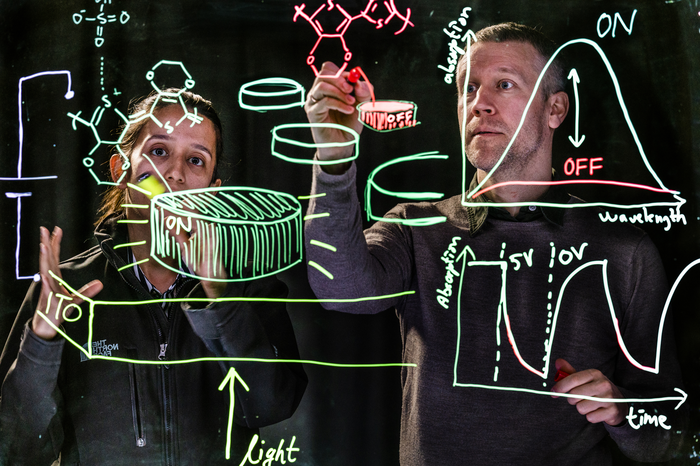Linköping University’s researchers have developed optical nanoantennas, which could be switched on/off and slowly tuned with the application of electrical potentials. The research opens for applications such as tuneable smart materials and dynamic flat metaoptics.
 Dr. Akchheta Karki and professor Magnus Jonsson showing how they developed dynamically tuneable plasmonic nanoantennas made from a conducting polymer, which can be switched between metallic and dielectric properties in the near infrared wavelength range. Image Credit: Thor Balkhed.
Dr. Akchheta Karki and professor Magnus Jonsson showing how they developed dynamically tuneable plasmonic nanoantennas made from a conducting polymer, which can be switched between metallic and dielectric properties in the near infrared wavelength range. Image Credit: Thor Balkhed.
The study was published in the journal Advanced Materials.
During medieval times, noble metals’ nanostructures were embedded in glass to make stunning colors. Although unaware at that time, the colors appear because the light at some frequencies converts into plasmons — the collective charge oscillations present in the metallic nanoparticles.
The nanoparticles serve as light antennas, making them extremely versatile. For instance, plasmonic nanoantennas are now tested in applications that range from energy conversion and photocatalysis to biosensing and flat metaoptics.
However, optical nanoantennas produced from usual metals like gold or silver have fixed features that are not possible to tune after fabrication. This has been a major drawback, limiting their usage in devices only to static functions.
With a vision of realizing dynamically tuneable nanoantennas, the team has started to study materials with optical properties that can be modified back and forth. The perfect example would be a material that can be repeatedly switched all the way between the optically metallic and dielectric states.
Such dynamically tuneable plasmonic nanoantennas developed from a conducting polymer, which can be switched in the near-infrared wavelength range between metallic and dielectric properties, have been demonstrated by the researchers at Linköping University in Sweden.
While polymers are traditionally known to be non-conducting plastics, conducting polymers cannot only transport electricity but their electrical conductivity can also be modulated via the redox state of the polymer. We explore this behavior for a new type of dynamic organic nanooptics.
Magnus Jonsson, Study Lead Author and Professor, Linköping University
In an article published earlier in Nature Nanotechnology, the same research team showed that some conducting polymers can be built to be sufficiently conducting to acquire plasmonic properties. Polymer-made nanoantennas can then be turned off and on again by exposing the samples to liquids and gases, which altered the redox state of the polymer.
Now, the researchers demonstrate electrical control of their polymeric plasmonic nanoantennas and, thereby, form an important step towards more beneficial and practical applications. This is one of the vital contributions of the new research.
By fabricating the conducting polymer nanoantennas on a transparent electrode and coating them with an ion-conducting gel, we could control their redox state by an external potential. Besides repeated on/off switching we demonstrate the possibility for gradual tuning of the nanoantennas, controlled by the external bias potential.
Dr. Akchheta Karki, Study Main Author, Linköping University
To better comprehend the fundamental mechanisms of the tuning process, the researchers relate their findings with optical simulations and calculations. The results show that both the mobility and density of the charge carriers in the nanoantennas differ while tuning, and the process is reversible.
Conducting polymers form an interesting new type of materials for dynamic nanooptics, thanks to the possibility to vary their properties between metallic and dielectric. In turn, the transition in the field from static to dynamic nanooptics is important for many future applications, including steerable metaoptics and dynamic smart windows.
Magnus Jonsson, Study Lead Author and Professor, Linköping University
The study was funded by the Knut and Alice Wallenberg Foundation through a Wallenberg Academy Fellowship, the Swedish Research Council, the Swedish Foundation for Strategic Research, and the Strategic Initiative in Advanced Functional Materials (AFM) at Linköping University.
Journal Reference:
Karki, A., et al. (2022) Electrical Tuning of Plasmonic Conducting Polymer Nanoantennas. Advanced Materials. doi.org/10.1002/adma.202107172.